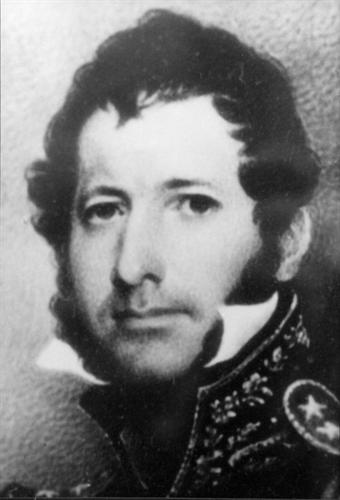
Hamilton, James, Jr.
In a state known for its flamboyant politicians, Hamilton was among the most colorful individuals to sit in the governor’s chair.
Congressman, governor. Hamilton was born near Charleston on May 8, 1786, to James Hamilton, Sr., a rice planter, and Elizabeth Lynch. He was educated at Newport, Rhode Island, and Dedham, Massachusetts, before returning to Charleston to read law under the tutelage of Daniel Huger and William Drayton. Admitted to the bar in 1810, Hamilton began practice in Drayton’s office and later became a partner of James L. Petigru. Volunteering for service in the War of 1812, Hamilton eventually rose to the rank of major. On November 15, 1813, he married the lowcountry heiress Elizabeth Heyward, gaining three plantations and two hundred slaves. The couple had eleven children.
In a state known for its flamboyant politicians, Hamilton was among the most colorful individuals to sit in the governor’s chair. As a member of South Carolina’s lowcountry aristocracy, Hamilton epitomized the chivalrous manner and deportment of planter society. A famous duelist, he successfully fought fourteen duels, always wounding but never killing his opponents. His prowess on the field of honor made Hamilton a much sought after second. Among the men he seconded were George McDuffie, Oliver Perry, Stephen Decatur, and John Randolph of Roanoke in his celebrated duel with Henry Clay. Hamilton was also one of Charleston’s most aggressive and reckless entrepreneurs, whose planting activities and land speculations were combined with extensive investments in numerous business, banking, and mercantile ventures.
Hamilton’s political career began in 1819, when he was elected to represent St. Philip’s and St. Michael’s Parishes in the South Carolina House of Representatives. Twice reelected, Hamilton resigned from the state legislature in December 1822 to fill a vacancy in the U.S. House of Representatives created by the resignation of William Lowndes. In that same year, Hamilton served as intendant (mayor) of Charleston, where he oversaw the response to Denmark Vesey’s slave conspiracy. As were most South Carolinians in the early and mid-1820s, Hamilton was a strong nationalist and ardent supporter of Andrew Jackson. He carried these views with him to Washington and, after the election of 1824, led the House opposition to the administration of John Quincy Adams. Hamilton continued to represent Charleston and the lowcountry in Congress until 1829, when he declined reelection and returned to South Carolina.
The passage of the Tariff of 1828 and his gradual conversion to states’ rights principles soon soured Hamilton on both an active federal government and Andrew Jackson. In a speech delivered at Walterboro on October 21, 1828, Hamilton publicly renounced his earlier nationalism and called for “a nullification by the State” of the despised tariff. Claiming precedent for such action in the Kentucky and Virginia Resolutions of Thomas Jefferson and James Madison, the speech at Walterboro launched the nullification movement in South Carolina and placed Hamilton at its forefront. On December 9, 1830, the legislature elected Hamilton governor and he assumed leadership of the States’ Rights and Free Trade Party, which he organized into local associations to popularize free trade ideas. While governor, Hamilton also presided over the 1832 Nullification Convention, which voted to nullify the tariff within South Carolina’s borders. After leaving office on December 10, 1832, Hamilton was made a brigadier general of the state militia by the new governor, Robert Hayne. In this role Hamilton prepared the state to defy federal authority with arms if necessary.
After the nullification crisis subsided, Hamilton turned his attention to his far-flung business pursuits, most of which soured in the Panic of 1837 and left him deeply indebted. Hamilton also became interested in the affairs of the newly independent Republic of Texas. He loaned the republic money and in 1838 was appointed loan commissioner for Texas by President Mirabeau Lamar. His duties carried him to Europe where he negotiated several commercial treaties and won recognition of the Republic of Texas from Great Britain and the Netherlands. Relieved of his post in 1842, Hamilton spent much of the remainder of his life shuttling between Texas, South Carolina, and Washington, D.C., trying to gain repayment of the money he loaned to Texas.
On November 15, 1857, Hamilton was en route to Texas, traveling on the steamer Opelousas, when it was struck by another ship just off Avery Island, Louisiana. Within half an hour the Opelousas had sunk. A gentleman to the end, Hamilton gave his life jacket to a woman and child and helped them into a lifeboat. Seconds later a wave swept Hamilton from the deck of the sinking ship and he drowned.
Freehling, William W. Prelude to Civil War: The Nullification Controversy in South Carolina, 1816–1836. New York: Harper & Row, 1965.
Kell, Carl Lewis. “A Rhetorical History of James Hamilton, Jr.: The Nullification Era in South Carolina, 1816–1834.” Ph.D. diss., University of Kansas, 1971.
Tinkler, Robert. James Hamilton of South Carolina. Baton Rouge: Louisiana State University Press, 2004.






